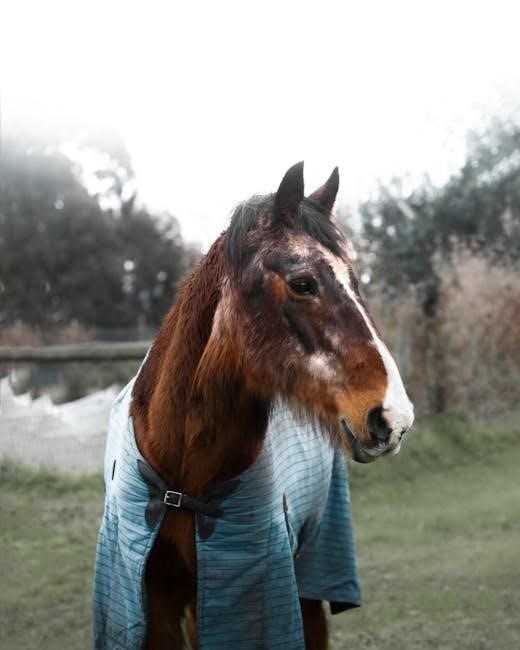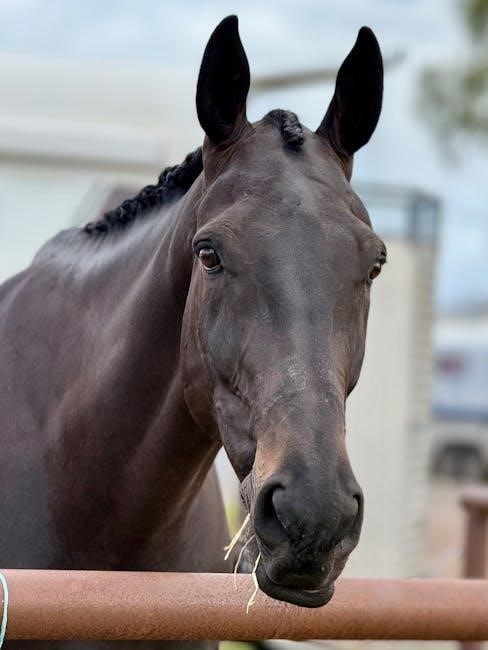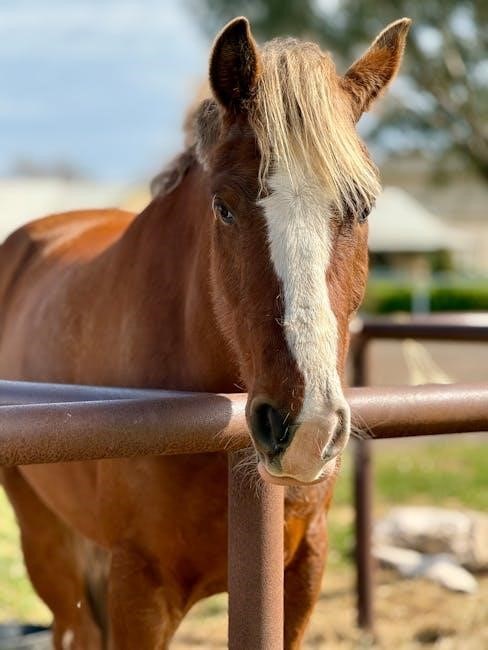Australia’s varying climate demands precise rugging strategies to ensure horse comfort and health. This guide provides essential insights to help owners make informed decisions for optimal temperature regulation.
Understanding the Importance of Rugging in Australian Climates
Rugging is essential in Australia’s diverse climate to protect horses from extreme temperatures, wind, rain, and sun exposure. It helps maintain coat condition, reduce feeding costs, and prevent health issues like chilling or overheating. Rugging also supports acclimatization to seasonal changes, ensuring comfort and well-being. By understanding local weather patterns and horse needs, owners can choose appropriate rugs to safeguard their horses’ health and optimize performance in varying conditions.
Objective of the Guide: Ensuring Horse Comfort and Health
This guide aims to provide horse owners with practical advice on selecting and using rugs to maintain their horses’ comfort and health in Australia’s varied climate. It focuses on understanding temperature regulation, coat types, and seasonal needs to prevent overheating or chilling. By addressing factors like weather, geography, and horse-specific conditions, the guide helps owners make informed decisions to protect their horses from environmental stressors, ensuring optimal well-being and performance throughout the year.

Understanding Horse Physiology and Temperature Regulation
Horses maintain a stable body temperature through natural coat insulation and physiological adaptations, essential for comfort across Australia’s diverse climate conditions and seasonal variations.
Normal Body Temperature Range in Horses
A horse’s normal body temperature ranges from 37.5°C to 38.5°C, playing a crucial role in determining rugging needs. This range helps identify overheating or chilling risks, especially in Australia’s varied climate. Monitoring temperature is vital to prevent heat stress or hypothermia, ensuring optimal comfort and health. Over-rugging can disrupt this balance, leading to issues like sweating and skin infections. Understanding this range aids in selecting the right rug weight and type, ensuring horses remain comfortable without compromising their natural physiological responses to environmental conditions.
How Horses Adapt to Different Temperatures
Horses adapt to temperature changes through their coat, behavior, and physiological responses. Their coat thickens in winter and sheds in summer to regulate heat. In cold weather, horses’ coats trap warm air, while in heat, they rely on sweating. Environmental factors like wind and rain can disrupt these natural mechanisms, making rugging essential. Horses acclimate to temperature shifts over 10-21 days, but sudden changes can stress them. Understanding these adaptations helps owners choose the right rugs to maintain comfort and prevent overheating or chilling, especially in Australia’s diverse climate conditions.
The Role of Coat in Insulation
A horse’s coat is a natural insulator, adapting to seasonal changes. In winter, a thick coat traps warm air close to the skin, while in summer, a lighter coat reflects heat. The coat’s effectiveness can be compromised by rain, wind, or improper rugging, which flattens the hairs and reduces insulation. Horses with full winter coats can stay warm in cold, dry conditions, but wet or windy weather necessitates rugging to maintain warmth. Understanding the coat’s role helps owners choose rugs that complement, rather than hinder, this natural insulation system, especially in Australia’s varied climate zones.

Factors Influencing Rugging Decisions
Weather, coat type, age, health, and living conditions are key factors. Australian regions vary widely, making rugging decisions unique to each horse’s specific needs and environment.
Geographical Location and Climate Variability
Australia’s diverse climate zones, from tropical to temperate and cold regions, significantly impact rugging choices. Horses in northern regions may require lighter rugs, while those in southern areas need heavier options. Climate variability, such as extreme heat in Queensland or cold winters in Victoria, dictates the type and weight of rugs. Regional weather patterns, including humidity and wind, further influence decisions. Understanding local conditions ensures appropriate rugging, preventing overheating or chilling. Each region’s unique climate requires tailored strategies for optimal horse comfort and health year-round.
Weather Conditions: Temperature, Humidity, Wind, and Rain
Weather conditions play a crucial role in determining the right rug for your horse. Temperature fluctuations, high humidity, strong winds, and rain can compromise a horse’s natural insulation. Waterproof rugs are essential during rain to prevent chilling, while lightweight options are better for humid days. Wind can strip away warmth, necessitating extra layers. Monitoring these factors helps in selecting rugs that maintain comfort without causing overheating. Adjusting rugs according to weather changes ensures your horse stays protected and comfortable in varying conditions throughout the year.
Horse’s Coat Type and Thickness
A horse’s coat type and thickness significantly influence rugging decisions. Horses with thin or clipped coats may require heavier rugs for insulation, while those with thick, natural coats may need lighter options to avoid overheating. The natural coat traps warm air, providing insulation, but this can be compromised by rain or wind. Lightweight rugs may flatten the coat, reducing its insulating properties. Clipped horses often need warmer rugs, especially in cold conditions, while unclipped horses may manage with less. Monitoring your horse’s coat and adjusting rugs accordingly ensures optimal comfort and prevents overheating.
Age and Health Status of the Horse
A horse’s age and health status play a crucial role in determining rugging needs. Foals and elderly horses often struggle to regulate their body temperature, requiring additional layers for warmth. Horses with health issues or compromised immune systems may benefit from extra insulation to prevent discomfort. Monitoring their condition and adjusting rugs seasonally ensures their well-being. Proper rugging can aid in maintaining their health, especially during extreme weather conditions, and prevent complications related to cold stress or overheating.
Horse’s Activity Level and Living Conditions
A horse’s activity level and living conditions significantly influence rugging decisions. Horses with high activity levels may require lighter rugs to prevent overheating, while those in cooler environments or with limited movement may need more insulation; Living conditions, such as access to shelter, exposure to wind, and whether the horse is stabled or in a paddock, also play a role. Adjusting rugs according to these factors ensures the horse remains comfortable and protected, regardless of its lifestyle or environment.

Types of Horse Rugs Available
Horse rugs come in lightweight, medium-weight, and heavyweight options, catering to different climates and needs. Materials vary, offering breathability, thermal insulation, or waterproofing for optimal protection and comfort.
Lightweight Rugs: Materials and Usage
Lightweight rugs are ideal for mild weather, offering protection without excess heat. Made from breathable materials like mesh or cotton, they shield horses from sun, wind, and insects. These rugs are perfect for autumn and spring or cooler summer nights. They often feature minimal filling, typically under 100g, ensuring comfort without overheating. Owners use them to maintain a short coat for shows or prevent insect-related discomfort. Lightweight rugs are versatile, suitable for both paddock and stable use, and are a must-have for varying Australian conditions.
Medium-Weight Rugs: Features and Benefits
Medium-weight rugs, typically filled with 150-200g of insulation, are perfect for cooler conditions, offering warmth without excess heat. Designed for temperatures between 5°C to 10°C, they provide excellent thermal insulation while maintaining breathability. These rugs are ideal for both paddock and stable use, protecting against wind and rain; They are particularly suitable for clipped or sensitive horses that need consistent warmth. Their durable materials and moisture-wicking properties ensure comfort, making them a versatile choice for Australian climates during autumn and winter transitions.
Heavyweight Rugs: When and How to Use
Heavyweight rugs, with 300-400g fill, are designed for extreme cold, ideal for temperatures below 5°C. They provide maximum insulation, making them perfect for clipped horses or those in freezing conditions. Use them in combination with neck covers for added warmth. Monitor your horse closely to prevent overheating, as over-rugging can lead to discomfort. These rugs are essential for elderly or sensitive horses needing extra protection. Their durable construction ensures longevity, but always ensure a proper fit to maintain breathability and comfort during harsh winter months in Australia.
Seasonal Rugging Guide
Australia’s diverse climate requires adaptive rugging strategies. Lightweight rugs for summer, medium-weight for autumn, heavyweight for winter, and versatile options for spring ensure optimal comfort and protection year-round.
Summer Rugging: Protection from Sun and Insects
Summer rugging focuses on protecting horses from harsh sunlight and biting insects. Lightweight, breathable mesh rugs offer airflow while shielding against flies and UV rays. Fly sheets or rugs with UPF protection are ideal for preventing sunburn and insect-related stress. These rugs are designed to keep horses cool and comfortable, even in high temperatures. However, it’s crucial to monitor your horse’s comfort, as overheating can occur. Always remove rugs during cooler evening hours and ensure proper ventilation to maintain your horse’s well-being during the warmer months.
Autumn Rugging: Transitioning to Cooler Weather
Autumn rugging helps horses adapt to cooling temperatures while managing variable weather conditions. Lightweight rugs with breathable materials are ideal for milder days, offering protection from wind and rain without overheating. As temperatures drop, layering rugs or switching to medium-weight options can provide additional warmth. Monitoring your horse’s comfort is key, as autumn’s fluctuating conditions can lead to overheating or chilling. Ensure rugs are waterproof and well-fitted to maintain insulation and prevent moisture buildup. Adjust rugging as needed to suit your horse’s individual needs and the season’s unpredictable changes.
Winter Rugging: Keeping Horses Warm and Dry
Winter rugging is crucial for maintaining your horse’s warmth and dryness in cold, wet conditions. Choose heavyweight rugs with high insulation, such as 400g fill, especially for clipped horses. Waterproof and breathable materials are essential to prevent moisture buildup. Layering rugs can enhance warmth, but monitor for signs of overheating. Older or ill horses may require extra protection. Ensure rugs fit well and offer neck coverage for maximum comfort. Regular checks are vital to ensure your horse remains comfortable and dry throughout the winter season.
Spring Rugging: Managing Variable Conditions
Spring rugging requires adaptability due to fluctuating temperatures and weather patterns. Lightweight to medium-weight rugs are ideal for this season, offering protection without excessive heat. Layering rugs allows for easy adjustment as temperatures rise or fall. Monitor your horse’s comfort to avoid over-rugging, as spring weather can quickly shift from cool to warm. Consider waterproof options for unexpected rain and UV protection for sunny days. Adjust rugs based on your horse’s coat condition and health status to ensure optimal comfort during this transitional period.
How to Choose the Right Rug
Selecting the right rug involves considering weather conditions, your horse’s activity level, and health status. Layering rugs can provide flexibility, while monitoring ensures optimal comfort and prevents overheating.
Measuring for the Correct Fit
Accurate measurements are key to ensuring your horse’s rug fits comfortably and functions properly. Use a soft tape measure to assess your horse’s size, starting from the center of the chest and extending to the base of the tail. Ensure the rug lies flat and allows for natural movement without restriction. Proper fit prevents over-rugging and discomfort. Regularly check the fit, especially during weight fluctuations or seasonal changes. A well-fitted rug ensures optimal protection, insulation, and comfort for your horse in varying temperatures and conditions.
Selecting the Appropriate Material
Choosing the right material for your horse’s rug is crucial for their comfort and health. Lightweight rugs often use breathable fabrics like mesh, ideal for warmer weather and insect protection. Medium-weight rugs may feature synthetic insulation, offering warmth without overheating. Heavyweight rugs typically use robust materials like wool or thick polyester, providing maximum insulation in cold conditions. Waterproof options are essential in rainy climates to keep your horse dry. Always consider your horse’s specific needs, such as moisture-wicking fabrics for humidity or durable fabrics for active horses, to ensure the rug performs effectively in various Australian climates.
Additional Features: Waterproofing, Fly Protection, etc.
Additional features in horse rugs enhance functionality and comfort. Waterproofing ensures your horse stays dry in rainy conditions, while fly protection materials, like mesh, shield against insects. Some rugs include UV protection to prevent coat bleaching. Breathable fabrics help regulate body temperature, preventing overheating. Neck covers and adjustable straps provide a secure fit. Reflective strips improve visibility, ensuring safety during evening rides. These features cater to diverse needs, from harsh weather to specific health conditions, making them invaluable for Australian climates with unpredictable weather patterns and abundant insect life.

Monitoring Your Horse’s Comfort
Regular checks ensure your horse isn’t too hot or cold. Look for signs like sweating, shivering, or discomfort, adjusting rugs as needed for optimal well-being.
Signs of Overheating
Monitor for excessive sweating, rapid breathing, and restlessness. Overheating can lead to heat stress, causing discomfort and health risks. Watch for signs like pawing the ground or trying to remove the rug. Adjust rugging to prevent overheating, especially in warmer conditions or high humidity. Ensure your horse stays cool and dry to avoid metabolic issues and maintain overall well-being.
Signs of Feeling Too Cold
A horse feeling too cold may exhibit shivering, a tucked-in posture, or a dull coat. They might also stand stiffly or seek shelter. Geographical variations in Australia mean horses in colder regions may need extra care. Monitor vulnerable horses, such as foals, older horses, or those with health issues, as they struggle more with cold. Ensure appropriate rugging to maintain comfort and prevent discomfort in cooler conditions, especially during windy or wet weather.
Adjusting Rugs According to Weather Changes
Monitoring weather fluctuations is crucial for maintaining your horse’s comfort. As temperatures drop, layer rugs to provide additional warmth, ensuring not to over-rug. In warmer spells, switch to lighter options or remove layers to prevent overheating. Waterproof rugs are essential during rain, but remove them once the weather clears to avoid trapping moisture. Adjusting rugs seasonally, such as using lightweight materials in summer and heavier ones in winter, ensures your horse stays comfortable throughout Australia’s diverse climate conditions.
Common Mistakes to Avoid
Over-rugging can lead to overheating, causing health issues like skin infections and metabolic disorders. Under-rugging exposes horses to cold stress, risking discomfort and illness.
Over-Rugging and Its Consequences
Over-rugging is a common mistake that can lead to overheating, causing health issues such as weight fluctuations, metabolic disorders, and bacterial skin infections. It can also result in laminitis and colic due to excessive heat stress. Horses may experience discomfort, sweating, and restlessness when over-rugged, especially in Australia’s diverse climate. Overheating can impair a horse’s ability to regulate its body temperature effectively, making it vulnerable to further health complications. Always monitor your horse’s behavior and adjust rugs according to weather conditions to prevent these risks.
Under-Rugging: Risks and Solutions
Under-rugging can leave horses too cold, especially in harsh Australian winters, leading to hypothermia and increased energy needs to stay warm. Without adequate insulation, horses may struggle to maintain their body heat, particularly in wet or windy conditions. To address this, ensure rugs match the climate and horse’s needs. Use rugs with appropriate fill levels, such as 200g for temperatures between 0°C and 5°C. Layering rugs as weather cools and ensuring waterproof, breathable materials can help prevent under-rugging. Regularly monitor your horse’s comfort and adjust their rugs accordingly to avoid health risks.
Mastering Australia’s horse rug temperature guide ensures optimal comfort and health. Consider climate, horse needs, and monitor regularly for a happy, thriving equine companion always.
Summarizing the Key Points
Understanding Australia’s climate variability is crucial for rugging decisions. Horses’ natural coats and physiological adaptations play a significant role in temperature regulation. Monitoring weather conditions, horse health, and activity levels ensures optimal rugging. Lightweight, medium, and heavyweight rugs serve different purposes, and seasonal adjustments are essential. Avoiding over- and under-rugging prevents health issues like overheating or chilling. Materials, fit, and additional features like waterproofing and fly protection are vital. Regular monitoring and adapting to changing conditions ensure horses remain comfortable and healthy year-round.
Final Tips for Effective Rugging
Always prioritize your horse’s comfort by selecting rugs tailored to their specific needs and local climate. Regularly monitor temperature fluctuations and adjust rugging accordingly. Consider layering rugs for flexibility in varying weather conditions. Ensure proper fit to prevent rubbing and discomfort. Opt for high-quality, breathable materials to maintain insulation without overheating. Start with lighter rugs and gradually increase weight as needed. Regularly inspect rugs for wear and tear to ensure durability. Acclimate your horse to new rugs gradually to prevent stress. Remember, every horse is unique, so tailor your approach for their optimal well-being.

Additional Resources
Explore expert articles and guides from trusted sources like Aussie Saddlery and equine professionals for comprehensive insights on rugging and horse care in Australia.
Recommended Reading and Expert Opinions
For deeper insights, explore Dr. Marlin’s work in Equine Exercise Physiology and articles like “The Science of Rugging” in Horses and People magazine. Visit Aussie Saddlery’s blog for practical guides and expert advice tailored to Australia’s climate. These resources offer comprehensive tips on selecting rugs, understanding horse physiology, and avoiding common mistakes, ensuring your horse stays comfortable year-round. They provide evidence-based strategies and real-world applications to enhance your rugging practices effectively.

